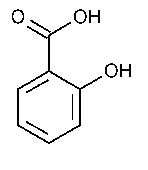Salicylic Acid
»Salicylic Acid contains not less than 99.5percent and not more than 101.0percent of C7H6O3,calculated on the dried basis.
Packaging and storage—
Preserve in well-closed containers.
Identification—
It meets the requirements of the tests for Salicylate á191ñ.
Loss on drying á731ñ—
Dry it over silica gel for 3hours:it loses not more than 0.5%of its weight.
Residue on ignition á281ñ:
not more than 0.05%.
Chloride á221ñ—
Heat 1.5g with 75mLof water until the acid is dissolved,cool,add water to restore the original volume,and filter:a 25-mLportion of the filtrate shows no more chloride than corresponds to 0.10mLof 0.020Nhydrochloric acid (0.014%).
Sulfate—
Dissolve 12.0g in 37mLof acetone,and add 3mLof water.Titrate potentiometrically with 0.02Mlead perchlorate,prepared by dissolving 9.20g of lead perchlorate in water to make 1000mLof solution,using a pHmeter capable of a minimum reproducibility of ±0.1mV(see pHá791ñ)equipped with an electrode system consisting of a lead-specific electrode and a silver-silver chloride reference glass-sleeved electrode containing a solution of tetraethylammonium perchlorate in glacial acetic acid (1in 44):not more than 1.25mLof 0.02Mlead perchlorate is consumed (0.02%).
Heavy metals—
Dissolve 1g in 25mLof acetone,and add 2mLof water.Add 1.2mLof thioacetamide-glycerin base TSand 2mLof pH3.5Acetate Buffer,and allow to stand for 5minutes:any color produced is not darker than that of a control made with 25mLof acetone and 2mLof Standard Lead Solution(see Heavy Metals á231ñ)and treated in the same manner.The limit is 20µg per g.
Related compounds—
Mobile phase—
Prepare a mixture of water,methanol,and glacial acetic acid (60:40:1).Make adjustments if necessary (see System Suitabilityunder Chromatography á621ñ).
Diluent—
Prepare a mixture of methanol,water,and glacial acetic acid (70:30:4).
Reference solutions—
Prepare a solution in Diluentcontaining about 0.05mg of 4-hydroxybenzoic acid and 0.025mg of 4-hydroxyisophthalic acid per mL,and a second solution in Diluentcontaining about 0.05mg of 4-hydroxybenzoic acid and 0.01mg of phenol per mL.
Standard solution—
Dissolve accurately weighed quantities of 4-hydroxybenzoic acid,4-hydroxyisophthalic acid,phenol,and the Salicylic Acid under test in Diluentto obtain a solution having known concentrations of about 0.05mg per mL,0.025mg per mL,0.01mg per mL,and 50mg per mL,respectively.
Test solution—
Prepare a solution of Salicylic Acid in Diluentcontaining 50mg per mL.Sonicate until completely dissolved.
Chromatographic system
(see Chromatography á621ñ)—The liquid chromatograph is equipped with a 270-nm detector and a 4.6-mm ×10-cm column containing 5-µm packing L1.The flow rate is about 0.5mLper minute.Chromatograph the Reference solutions,record the chromatograms,and note the retention times of the peaks.Chromatograph the Standard solution,and record the peak responses as directed for Procedure:the relative retention times are about 0.35,0.45,0.5,and 1.0for 4-hydroxybenzoic acid,4-hydroxyisophthalic acid,phenol,and salicylic acid,respectively,and the peaks are all baseline-resolved from each other.Changes in the composition of the Mobile phasemade to optimize resolution may change the elution order of impurities.Use the chromatograms obtained from the Reference solutionsto determine the elution order of the specified impurities.
Procedure—
Separately inject equal volumes (about 2µL)of the Standard solutionand the Test solutioninto the chromatograph,record the chromatograms,and measure the areas for the major peaks.Calculate the percentage of each relevant related compound taken by the formula:
2Ci[ri/(rSi-ri)],
in which Ciis the concentration,in mg per mL,of the relevant related compound in the Standard solution;and riand rSiare the peak responses for the relevant related compound obtained from the Test solutionand the Standard solution,respectively:not more than 0.1%of 4-hydroxybenzoic acid,0.05%of 4-hydroxyisophthalic acid,and 0.02%of phenol is found.Calculate the percentage of any other impurity,other than the solvent peak,observed in the chromatogram of the Test solutionby the same formula,except to use the concentration of 4-hydroxyisophthalic acid in the Standard solutionas Ci;the response of the peak of 4-hydroxyisophthalic acid in the chromatogram obtained from the Standard solutionas rSi;and the response of any other impurity as ri:not more than 0.05%of any other impurity is found;and the sum of all of the related compounds and other impurities found is not more than 0.2%.
Assay—
Dissolve about 500mg of Salicylic Acid,accurately weighed,in 25mLof diluted alcohol that previously has been neutralized with 0.1Nsodium hydroxide,add phenolphthalein TS,and titrate with 0.1Nsodium hydroxide VS.Each mLof 0.1Nsodium hydroxide is equivalent to 13.81mg of C7H6O3.
Auxiliary Information—
Staff Liaison:Lawrence Evans,III,Ph.D.,Scientist
Expert Committee:(PA6)Pharmaceutical Analysis 6
USP28–NF23Page 1747
Phone Number:1-301-816-8389
